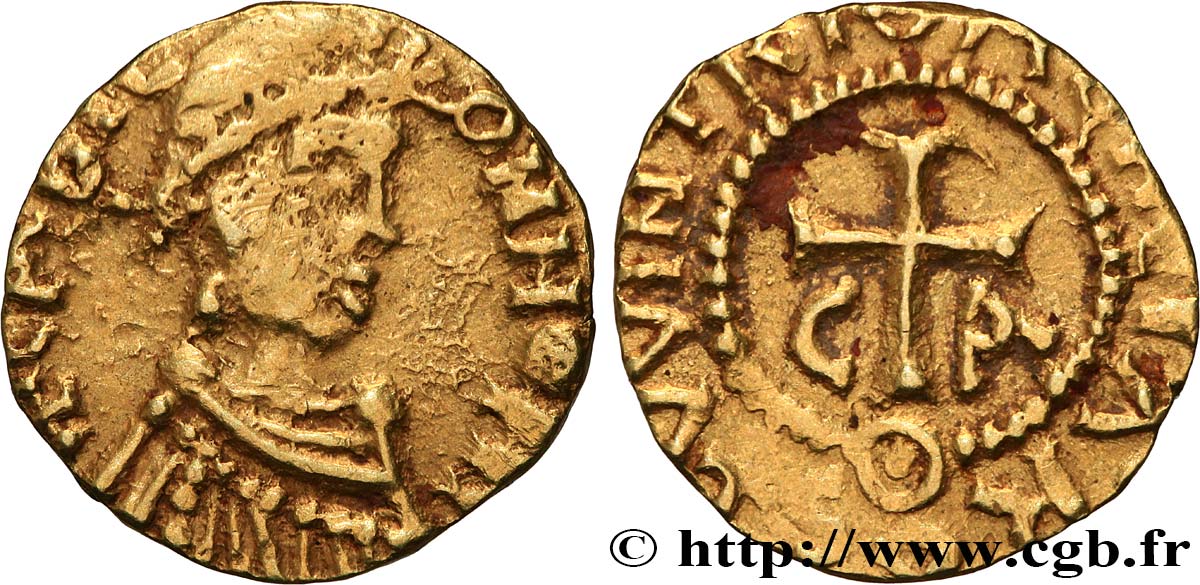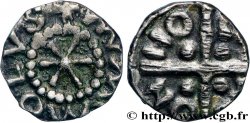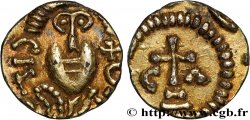Live auction - bmv_641044 - CHALON - SUR - SAÔNE (CABILONNUM) Triens, monétaire VINTRIO
Devi Sign-in ed essere un offerente approvato fare un'offerta, Login per fare offerte. Conti sono soggetti ad approvazione e di approvazione sono raggiunti entro 48 ore. Non aspettare fino al giorno di una vendita si chiude per registrarti.Confermando la tua offerta su questo oggetto ti impegni ad un contratto legalmente vincolante per l'acquisto di questo prodotto e fare clic su «offerta» costituisce accettazione dei termini di utilizzo de live auctions cgb.fr.
Offerta deve essere collocato in euro gli importi interi vendita only.The si chiuderà al momento sulla descrizione dell'oggetto, eventuali offerte pervenute al sito dopo l'orario di chiusura non verranno eseguite. Volte transmition possono variare e le offerte potrebbero essere respinto se si attende per gli ultimi secondi. Per ulteriori informazioni ckeck le FAQ Live auction.
Le offerte vincenti saranno sottomesse ai 18% per spese di compartecipazione alla vendita.
Le offerte vincenti saranno sottomesse ai 18% per spese di compartecipazione alla vendita.
| Valutazione : | 2 500 € |
| Prezzo : | no offerta |
| Offerta maxima : | no offerta |
| Data di fine vendita : | 09 marzo 2021 16:15:06 |
Tipo : Triens, monétaire VINTRIO
Data: (VIIe siècle)
Nome della officina / città: Chalon-sur-Saône (71)
Metallo : oro
Diametro : 12 mm
Asse di coniazione : 6 h.
Peso : 1,20 g.
Grado di rarità : R2
Commenti sullo stato di conservazione:
Ce triens présente des reliefs plus nets au revers qu’au droit. Une partie de la légende du droit est hors flan
N° nelle opere di riferimento :
Diritto
Titolatura diritto : + CA[BIL]-ONNO FIT.
Descrittivo diritto : Buste à droite, diadème de perles sommé d’un croissant et attaché par trois rubans terminés par des globules ; manteau avec anneau d’attache à l’angle gauche et globules à l’angle droit.
Rovescio
Titolatura rovescio : VVINTRIO [MON]ETAR.
Descrittivo rovescio : Croix latine sur deux degrés, accostée de CA, dans un diadème de perles avec un anneau centré.
Commento
Cette monnaie appartient au quatrième groupe du monnayage mérovingien attribué à Chalon-sur-Saône. Avec la croix (non chrismée) reposant sur l’anneau centré, ce triens est comparable au n° 1167 du Belfort et au n° 46 et 54 de l’ouvrage de Ponton d’Amécourt.
Le monnayage de Cabilonnum est divisé en plusieurs groupes. Le premier regroupe les monnaies épiscopales (STEPHANVS EPISCOPVS). Le deuxième est dit "de transition", avec des monétaires tels que NONNVS, PRISCVS, DOMNOLVS, DOMNITIVS, BONNASIVS et CHLOTHARIVS. Le troisième est pour DOMNITTVS, BAIVLFVS, BAIO, BAVDOMERE, RIGNOALDVS, FRATERNVS et ABBO. Le quatrième groupe est principalement constitué de monnaies de VVINTRIO dont le Belfort recense 45 numéros (n° 1152 - 1196). Ce monétaire est ensuite associé à BONEFACIVS puis à BETTO. Le cinquième groupe reprend les pièces imitées des types de VVINTRO et du quatrième groupe. Le dernier groupe (huitième au Belfort) regroupe les monnaies de cuivre et d'argent sur lesquelles ont retrouve le nom de certains monétaires mentionnés sur l'or. Comme le faisait remarquer le Vicomte Ponton d'Amécourt, "Wintrio a émis à lui seul presque autant de monnaies que tous les autres monétaires de Chalon réunis ; ses coins varient à l'infini dans un cadre fort restreint du reste, dont les caractères généraux sont toujours les mêmes : au droit un buste de profil regardant à droite ; au revers une croix accostée des lettres CA, dans un diadème de perles." Selon l'auteur, Wintrio pourrait être considéré comme le monétaire de Clotaire. Le monnayage de Wintrio est lui-même divisé en plusieurs périodes, selon le type de vêtement, de nœud du diadème. Wintrio s'est adjoint à plusieurs monétaires qui ont signé avec lui. Sur un exemplaire (unique en 1866 et dont la légende du monétaire est incomplète), Wintrio "se pose en personnage, ne s'attribuant plus la qualité de monétaire ; il inscrit son nom magistralement au droit de la monnaie tandis que le monétaire signe au revers avec la qualification de monétaire.
This coin belongs to the fourth group of Merovingian coinage attributed to Chalon-sur-Saône. With the cross (not chrismated) resting on the centered ring, this triens is comparable to n° 1167 of Belfort and to n° 46 and 54 of the work of Ponton d'Amécourt.
The coinage of Cabilonnum is divided into several groups. The first includes episcopal coins (STEPHANVS EPISCOPVS). The second is called \\\"transitional\\\", with coins such as NONNVS, PRISCVS, DOMNOLVS, DOMNITIVS, BONNASIVS and CHLOTHARIVS. The third is for DOMNITTVS, BAIVLFVS, BAIO, BAVDOMERE, RIGNOALDVS, FRATERNVS and ABBO. The fourth group is mainly made up of VVINTRIO coins, of which Belfort lists 45 numbers (n° 1152 - 1196). This coin is then associated with BONEFACIVS then with BETTO. The fifth group includes the imitated pieces of the VVINTRO types and the fourth group. The last group (eighth in Belfort) includes copper and silver coins on which we find the name of certain mints mentioned on the gold. As Viscount Ponton d'Amécourt noted, \\\"Wintrio alone issued almost as many coins as all the other mints of Chalon combined; his dies vary infinitely within a very restricted framework, the general characteristics of which are always the same: on the obverse a bust in profile looking to the right; on the reverse a cross flanked by the letters CA, in a pearl diadem. \\\"According to the author, Wintrio could be considered as Clotaire's coiner. The coinage of Wintrio is itself divided into several periods, according to the type of garment, knot of the diadem. Wintrio has joined forces with several monetaries who have signed with him. On one example (unique in 1866 and whose mint legend is incomplete), Wintrio \\\"poses himself as a character, no longer attributing to himself the quality of mint; he inscribes his name masterfully on the obverse of the coin while the mint signs on the reverse with the qualification of mint
Le monnayage de Cabilonnum est divisé en plusieurs groupes. Le premier regroupe les monnaies épiscopales (STEPHANVS EPISCOPVS). Le deuxième est dit "de transition", avec des monétaires tels que NONNVS, PRISCVS, DOMNOLVS, DOMNITIVS, BONNASIVS et CHLOTHARIVS. Le troisième est pour DOMNITTVS, BAIVLFVS, BAIO, BAVDOMERE, RIGNOALDVS, FRATERNVS et ABBO. Le quatrième groupe est principalement constitué de monnaies de VVINTRIO dont le Belfort recense 45 numéros (n° 1152 - 1196). Ce monétaire est ensuite associé à BONEFACIVS puis à BETTO. Le cinquième groupe reprend les pièces imitées des types de VVINTRO et du quatrième groupe. Le dernier groupe (huitième au Belfort) regroupe les monnaies de cuivre et d'argent sur lesquelles ont retrouve le nom de certains monétaires mentionnés sur l'or. Comme le faisait remarquer le Vicomte Ponton d'Amécourt, "Wintrio a émis à lui seul presque autant de monnaies que tous les autres monétaires de Chalon réunis ; ses coins varient à l'infini dans un cadre fort restreint du reste, dont les caractères généraux sont toujours les mêmes : au droit un buste de profil regardant à droite ; au revers une croix accostée des lettres CA, dans un diadème de perles." Selon l'auteur, Wintrio pourrait être considéré comme le monétaire de Clotaire. Le monnayage de Wintrio est lui-même divisé en plusieurs périodes, selon le type de vêtement, de nœud du diadème. Wintrio s'est adjoint à plusieurs monétaires qui ont signé avec lui. Sur un exemplaire (unique en 1866 et dont la légende du monétaire est incomplète), Wintrio "se pose en personnage, ne s'attribuant plus la qualité de monétaire ; il inscrit son nom magistralement au droit de la monnaie tandis que le monétaire signe au revers avec la qualification de monétaire.
This coin belongs to the fourth group of Merovingian coinage attributed to Chalon-sur-Saône. With the cross (not chrismated) resting on the centered ring, this triens is comparable to n° 1167 of Belfort and to n° 46 and 54 of the work of Ponton d'Amécourt.
The coinage of Cabilonnum is divided into several groups. The first includes episcopal coins (STEPHANVS EPISCOPVS). The second is called \\\"transitional\\\", with coins such as NONNVS, PRISCVS, DOMNOLVS, DOMNITIVS, BONNASIVS and CHLOTHARIVS. The third is for DOMNITTVS, BAIVLFVS, BAIO, BAVDOMERE, RIGNOALDVS, FRATERNVS and ABBO. The fourth group is mainly made up of VVINTRIO coins, of which Belfort lists 45 numbers (n° 1152 - 1196). This coin is then associated with BONEFACIVS then with BETTO. The fifth group includes the imitated pieces of the VVINTRO types and the fourth group. The last group (eighth in Belfort) includes copper and silver coins on which we find the name of certain mints mentioned on the gold. As Viscount Ponton d'Amécourt noted, \\\"Wintrio alone issued almost as many coins as all the other mints of Chalon combined; his dies vary infinitely within a very restricted framework, the general characteristics of which are always the same: on the obverse a bust in profile looking to the right; on the reverse a cross flanked by the letters CA, in a pearl diadem. \\\"According to the author, Wintrio could be considered as Clotaire's coiner. The coinage of Wintrio is itself divided into several periods, according to the type of garment, knot of the diadem. Wintrio has joined forces with several monetaries who have signed with him. On one example (unique in 1866 and whose mint legend is incomplete), Wintrio \\\"poses himself as a character, no longer attributing to himself the quality of mint; he inscribes his name masterfully on the obverse of the coin while the mint signs on the reverse with the qualification of mint








 Segnalare un errore
Segnalare un errore Stampate la pagina
Stampate la pagina Condividi mia selezione
Condividi mia selezione Fai una domanda
Fai una domanda Consegnare / vendere
Consegnare / vendere
 Descrittivo
Descrittivo










